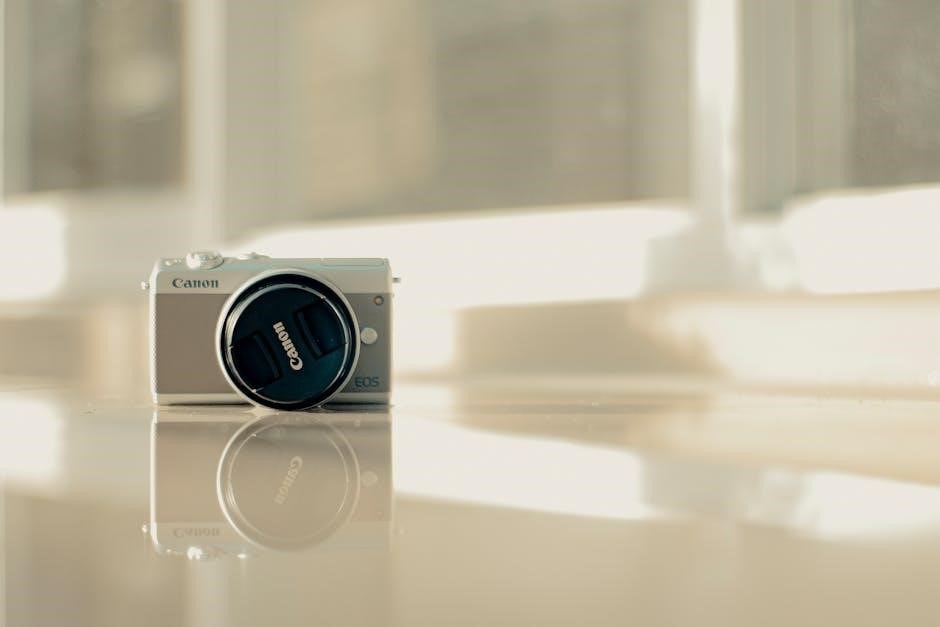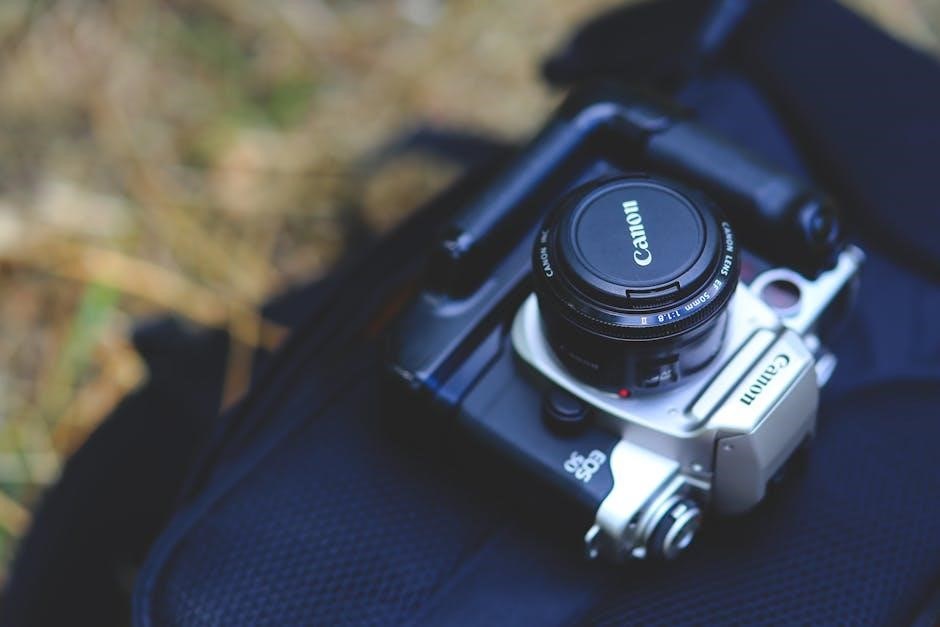Welcome to the Canon EOS R50 manual, your comprehensive guide to mastering this versatile mirrorless camera. This manual covers everything from basic operations to advanced features, ensuring you unlock its full potential for stunning photography and videography.
Key Features of the Canon EOS R50
The Canon EOS R50 boasts a 24.2-megapixel APS-C sensor, delivering crisp images and 4K video recording. It features a vari-angle touchscreen LCD, perfect for vlogging and creative shooting angles. With up to 60 FPS burst mode, it excels in capturing fast-moving subjects. The camera supports dual SD card slots, enhancing storage flexibility. Its compact design and lightweight build make it ideal for everyday use. The EOS R50 also offers advanced autofocus, including subject detection, and compatibility with Canon’s EF-M and RF lenses. Firmware updates ensure continuous improvement, keeping your camera up-to-date with the latest features.
Target Audience for the EOS R50
The Canon EOS R50 is designed for entry-level photographers, hobbyists, and content creators seeking a compact yet powerful mirrorless camera. It’s ideal for vloggers and social media enthusiasts due to its lightweight design and vari-angle touchscreen. The camera also appeals to beginners transitioning from smartphones or basic cameras, offering intuitive controls and advanced features. Its affordability and versatility make it a great choice for those looking to explore photography and videography without compromising on quality. Whether for personal projects or professional use, the EOS R50 caters to a wide range of creative needs.

Getting Started with the Canon EOS R50
Getting started with the Canon EOS R50 is straightforward. This section guides you through unboxing, initial setup, and understanding the camera’s layout and controls.
Unboxing and Initial Setup
Unboxing the Canon EOS R50 reveals the camera body, a kit lens, battery, charger, and manual. Begin by charging the battery fully before first use. Insert a compatible memory card into the slot, ensuring it’s formatted for the camera. Power on the camera and navigate through the initial setup menu to configure language, date, time, and Wi-Fi settings. Familiarize yourself with the camera’s ports and buttons. Refer to the manual for detailed instructions on pairing accessories like lenses or external flashes. This setup ensures you’re ready to start capturing high-quality photos and videos right away.
Understanding the Camera’s Layout
The Canon EOS R50 features a compact and intuitive design. The mode dial on top allows quick access to shooting modes, while the shutter button and adjacent control dial simplify operation. The vari-angle touchscreen LCD offers flexible framing and focusing. Rear buttons include the Menu, Info, and Playback controls, with the AF/MF switch and zoom controls on the lens. The memory card slot and USB-C port are located on the side. Familiarizing yourself with this layout ensures efficient navigation and enhances your shooting experience, making it easier to adjust settings and capture moments seamlessly.
Basic Camera Controls and Buttons
The Canon EOS R50 features a user-friendly interface with essential controls for seamless operation. The mode dial on top allows quick switching between shooting modes, while the shutter button, located beside the control dial, enables easy capture. The multi-controller on the rear provides navigation and AF point selection. The Quick Control Dial simplifies adjustments like aperture and shutter speed. Dedicated buttons for video recording, playback, and menu access streamline workflow. The AF/MF switch on the lens ensures focus control, and the vari-angle touchscreen LCD offers intuitive tap-to-focus and settings adjustment. These controls empower photographers to customize and capture with precision and ease.

Basic Camera Operations
The Canon EOS R50 offers intuitive shooting modes, precise autofocus, and seamless video recording. Its user-friendly interface allows easy navigation and customization for optimal photography experiences.
Shooting Modes Explained
The Canon EOS R50 offers a variety of shooting modes to suit different photography needs. Scene Intelligent Auto mode simplifies capture by automatically adjusting settings. Creative Zone modes, such as Manual, Aperture Priority, Shutter Priority, and Program, provide control for advanced users. Special Scene modes like Portrait, Landscape, and Sports optimize settings for specific subjects. Additionally, the camera features a dedicated Movie mode for video recording. These modes ensure versatility, catering to both beginners and experienced photographers, allowing for precise control and creative expression in various shooting scenarios.
Navigation and Menu System
The Canon EOS R50 features an intuitive menu system designed for easy navigation. The camera’s touch screen allows for quick access to settings, while the menu is organized into tabs for efficient browsing. Key tabs include Image Shooting, Video Shooting, Playback, Setup, and Custom Functions. Users can customize the menu to display frequently used settings, streamlining the workflow. The My Menu option lets you save up to six personalized settings for quick access. Clear explanations for each menu item are provided, making it user-friendly for both beginners and advanced photographers.
Focus Modes and Autofocus Settings
The Canon EOS R50 offers advanced autofocus capabilities with multiple focus modes to suit various shooting scenarios. The camera features Face+Tracking AF, Spot AF, and Zone AF, allowing precise control over focus areas. Users can customize autofocus settings, such as adjusting tracking sensitivity and enabling subject detection for improved accuracy. The EOS R50 also supports Eye AF for capturing sharp portraits. Additionally, the camera allows for manual focus override, giving photographers flexibility in creative shooting situations. These features ensure fast and accurate focusing, making the EOS R50 ideal for both stills and video recording.
Advanced Features of the EOS R50
The EOS R50 boasts advanced features like 4K video recording, high-speed continuous shooting, and customizable controls. It also supports manual focus overrides for enhanced creativity and precision.
Customizing Settings for Personalized Use
The Canon EOS R50 allows users to tailor settings to their preferences, enhancing workflow efficiency. Customizable buttons and dials enable quick access to frequently used functions. The camera also supports personalized shooting profiles, making it easy to switch between setups for different scenarios. Additionally, the EOS R50 offers advanced autofocus customization, allowing users to fine-tune tracking sensitivity and subject detection. These features empower photographers and videographers to adapt the camera to their unique needs, ensuring a seamless and intuitive shooting experience. Firmware updates further expand customization options, keeping the camera up-to-date with the latest enhancements.
Video Recording Capabilities
The Canon EOS R50 excels in video recording, offering high-quality 4K resolution and smooth 60 FPS capture. It features advanced Dual Pixel AF for precise subject tracking and stabilization for steady footage. The camera supports various video modes, including HDR and time-lapse, catering to both casual and professional creators. A vari-angle touchscreen enhances framing flexibility, while external microphone support ensures high-quality audio. These capabilities make the EOS R50 an excellent choice for vloggers, content creators, and filmmakers seeking versatility and performance in a compact form factor.
Firmware Updates and Maintenance
Regular firmware updates are essential for optimizing the Canon EOS R50’s performance. To update, access the camera’s menu, select “Firmware” under the settings, and follow on-screen instructions. Updates can also be done via Canon’s official website or using the Canon Camera Connect app. Ensure the camera is fully charged or connected to a power source during updates. Proper maintenance includes cleaning the sensor and lens regularly, storing the camera in a dry environment, and using a protective case. These practices ensure longevity and optimal functionality of your EOS R50, keeping it ready for capturing high-quality images and videos.

Photography and Videography Tips
Master your Canon EOS R50 with expert tips for photography and videography. Learn composition, lighting, and manual controls to capture stunning images and videos with ease and creativity.
Optimizing Image Quality
The Canon EOS R50 delivers exceptional image quality with its 24.2MP APS-C sensor and DIGIC X processor. For optimal results, shoot in RAW format to retain maximum detail and flexibility during post-processing. Adjust white balance settings to match your lighting conditions, and utilize the camera’s autofocus system for sharp, precise subject capture. Experiment with manual controls like ISO and aperture to achieve desired effects. Regular firmware updates ensure the camera performs at its best. By mastering these settings and techniques, you can unlock the full potential of the EOS R50 for professional-grade photography.
Best Practices for Video Recording
For exceptional video results with the Canon EOS R50, start by enabling 60 FPS for smooth motion and use manual controls to adjust exposure and focus. Leverage the camera’s vari-angle touchscreen for precise focus tracking and framing. Stabilization is key, so use a tripod or handheld stabilizer for steady footage. Shoot in 4K resolution for crisp detail and consider using prime lenses for shallow depth of field. Monitor audio quality and use an external microphone if needed. Regularly clean the sensor and update firmware to ensure optimal performance. By following these practices, you can capture professional-grade video with ease.

Using Manual Controls for Creative Photography
The Canon EOS R50 offers robust manual controls, empowering photographers to craft unique images. Adjust aperture, shutter speed, and ISO to achieve desired effects, such as shallow depth of field or motion blur. Use the touchscreen to precisely focus and experiment with manual focus for artistic control. Shoot in RAW format to capture maximum detail for post-processing. Explore creative techniques like panning, long exposures, and astrophotography. Utilize the exposure compensation dial for fine-tuned brightness. By mastering these manual controls, you can unlock the EOS R50’s full creative potential and produce standout photographs tailored to your vision.
Technical Specifications
The Canon EOS R50 features a 24.2MP APS-C CMOS sensor, DIGIC X processor, 4K/60p video, vari-angle touchscreen LCD, ISO 100-32,000 (expandable), and Dual SD/SDHC/SDXC card slots.
Sensor and Processor Details
The Canon EOS R50 is equipped with a 24.2MP APS-C CMOS sensor, delivering crisp and detailed images. Paired with the DIGIC X image processor, it ensures fast operation, improved noise reduction, and enhanced color accuracy. The sensor’s back-illuminated design optimizes light capture, while the processor enables advanced autofocus and 4K/60p video recording. With an ISO range of 100-32,000 (expandable), the camera performs well in various lighting conditions. The Dual Pixel AF II technology, driven by the DIGIC X processor, provides rapid and precise autofocus, making it ideal for both stills and video.
ISO Range and Noise Performance
The Canon EOS R50 features an ISO range of 100-32,000, expandable to 51,200 for low-light conditions. Equipped with the DIGIC X processor, the camera delivers excellent noise reduction, ensuring clean images even at higher ISO settings. The advanced noise-processing algorithms minimize grain while preserving detail, making it suitable for both still photography and video recording. In low-light environments, the EOS R50 performs admirably, maintaining color accuracy and reducing digital artifacts. This capability makes it a versatile choice for photographers working in diverse lighting scenarios, from bright daylight to dim indoor settings.
Continuous Shooting and Buffer Capacity
The Canon EOS R50 supports continuous shooting at up to 12 frames per second (fps) with the mechanical shutter and 15 fps with the electronic shutter, ideal for capturing dynamic action. The buffer capacity allows for a generous number of shots before slowing down, making it suitable for sports and wildlife photography. When using a fast SD card, the camera efficiently clears the buffer, enabling quick resumption of shooting. This feature ensures you never miss a critical moment, whether photographing fast-moving subjects or documenting fleeting events.
Troubleshooting Common Issues

Resolve error messages, connectivity problems, and battery issues with detailed solutions. The manual provides step-by-step guidance to address common challenges, ensuring optimal performance and uninterrupted use of your EOS R50.
Resolving Error Messages
The Canon EOS R50 manual provides detailed solutions for common error messages. From memory card issues to lens communication problems, the guide offers step-by-step troubleshooting. Learn how to reset the camera, clean the lens, and update firmware to resolve errors. If issues persist, the manual directs users to Canon’s official support website for further assistance. This section ensures you can quickly address and fix problems, keeping your photography sessions uninterrupted and your camera functioning optimally.
Fixing Connectivity Problems
Connectivity issues with the Canon EOS R50 can often be resolved by restarting the camera or ensuring Wi-Fi and Bluetooth settings are enabled. Check the camera’s network settings and confirm the firmware is up to date. If problems persist, reset the camera to its default settings or use Canon’s official software for troubleshooting. The manual also provides guidance on pairing devices and resolving connection errors, ensuring seamless communication between the camera and your smartphone or computer for efficient file transfer and remote control functionality.
Addressing Battery and Charging Issues
If you encounter battery or charging issues with your Canon EOS R50, start by ensuring you’re using genuine Canon batteries and the provided charger. Check the firmware version and update if necessary, as newer versions often resolve such problems. Clean the battery terminals with a soft cloth and ensure they are free from dirt or corrosion. If the battery doesn’t charge, try resetting the camera by pressing and holding the power button for 10 seconds. For persistent issues, refer to the manual or contact Canon support for assistance. Proper maintenance ensures optimal battery performance and longevity.

Accessories and Compatibility
Explore compatible accessories for the Canon EOS R50, including lenses, flashes, and storage solutions, to enhance your photography and videography experience and ensure optimal performance.
Recommended Lenses for the EOS R50
The Canon EOS R50 is compatible with a variety of RF and RF-S lenses, offering versatility for different photography needs. For starters, the Canon RF-S 18-45mm f/4.5-6.3 IS STM is an excellent kit lens, providing a wide-angle to standard zoom range with image stabilization. For portraits, the Canon RF 50mm f/1.8 STM is a lightweight and affordable prime lens with a wide aperture for creamy bokeh. The Canon RF 10-22mm f/4-5.6 IS STM is ideal for landscape and architecture photography, while the Canon RF 100-400mm f/5;6-8 IS STM is perfect for wildlife and telephoto shots. These lenses ensure optimal performance and compatibility with the EOS R50’s APS-C sensor, delivering sharp and high-quality images.
External Flash and Lighting Options
The Canon EOS R50 supports external flash units for enhanced lighting control. The Canon Speedlite EL-100 is a compact and versatile option, offering wireless functionality and a bounce head for soft, natural illumination. Additionally, the camera is compatible with other Speedlite models, such as the EL-5, allowing for advanced lighting setups. For studio photography, Canon’s Speedlite Transmitter ST-E3-RT enables wireless control of multiple flash units. External lighting options like ring lights or LED panels can also be used for vlogging and portrait photography, providing professional-grade results. These accessories expand the EOS R50’s capabilities, ensuring optimal lighting in various shooting scenarios.
Compatible Memory Cards and Storage Solutions
The Canon EOS R50 supports SD, SDHC, and SDXC memory cards, ensuring ample storage for high-resolution photos and videos. For optimal performance, use UHS-I or UHS-II compatible cards, which enable faster data transfer speeds. The camera features a single SD card slot, making it essential to choose high-capacity cards for extended shooting sessions. Additionally, external storage solutions like portable SSDs can be connected via USB-C for backup and offloading content. Always use reliable brands like SanDisk, Lexar, or Toshiba for consistent performance and durability, ensuring your data is safely stored and easily accessible.

Maintenance and Care
Regularly clean the camera and lens to prevent dust and smudges. Store the EOS R50 in a dry, cool place away from direct sunlight. Handle with care to avoid scratches and damage. Avoid exposure to harsh chemicals or extreme temperatures. Use a soft cloth for cleaning and original Canon accessories to maintain optimal performance and longevity.
Cleaning the Camera and Lens
Regular cleaning is essential to maintain the Canon EOS R50’s performance. Use a soft, dry microfiber cloth to gently wipe the camera body and lens surfaces. For stubborn smudges, lightly dampen the cloth with distilled water or a lens cleaning solution, but avoid harsh chemicals. Never touch the lens surface with your fingers, as oils can leave residue. Clean the lens in a circular motion, starting from the center and moving outward. Avoid using tissues or paper products, as they may scratch the lens. After cleaning, inspect the lens and dry it thoroughly to prevent water spots. Proper cleaning ensures sharp images and prevents damage to your equipment.
Storing the Camera Properly
Proper storage is crucial to protect your Canon EOS R50. Store the camera in a cool, dry place, away from direct sunlight and moisture. Use a protective case or pouch to prevent scratches and dust accumulation. Avoid extreme temperatures, as they can damage the camera’s internal components. When not in use, remove the battery and store it separately in a cool, dry location. For long-term storage, consider using silica gel packets to absorb moisture; Always detach the lens and store it with lens caps to prevent dust and damage. Proper storage ensures your camera remains in optimal condition for future use.
Regular Maintenance Tips
Regular maintenance is essential to keep your Canon EOS R50 in top condition. Clean the camera body and lens regularly using a soft, dry microfiber cloth to prevent dust buildup. For stubborn smudges, use a lens cleaning solution with a microfiber cloth. Update the camera firmware periodically to ensure optimal performance and access to new features. Inspect the camera and lens for physical damage or debris. Store the camera in a dry environment and avoid extreme temperatures. Clean the memory card contacts with a soft cloth to maintain proper connectivity. Regularly check and replace the camera’s battery if it shows signs of degradation. By following these tips, you can extend the lifespan of your EOS R50 and ensure it continues to deliver exceptional results.
Canon EOS R50 Ecosystem
The Canon EOS R50 integrates seamlessly into Canon’s mirrorless ecosystem, offering compatibility with a wide range of RF lenses, accessories, and software tools for enhanced functionality and creativity.
Canon’s Mirrorless Camera Lineup
The Canon EOS R50 is the latest addition to Canon’s expanding mirrorless camera lineup, blending portability and power. It joins models like the EOS R8 and R10, offering a compact yet capable option for photographers and videographers. Designed as a successor to the M50 Mark II, the R50 inherits its small form factor while enhancing features like resolution and autofocus. With a 24.2MP APS-C sensor, 4K video capabilities, and a vari-angle touchscreen, the R50 caters to both beginners and enthusiasts. It exemplifies Canon’s strategy to provide accessible, high-performance mirrorless cameras without compromising on quality or creativity.
Software and Apps for EOS R50
The Canon EOS R50 is supported by a range of software and apps to enhance your photography experience. Canon’s Camera Connect app allows seamless image transfer and remote shooting via smartphones. Digital Photo Professional simplifies RAW file editing, while EOS Utility enables firmware updates and custom settings. These tools empower users to streamline workflows, edit photos, and maintain their camera’s performance. Regular updates ensure compatibility and improved functionality, making the EOS R50 a versatile choice for both casual and professional use. Explore these resources to maximize your camera’s potential and stay connected to Canon’s ecosystem.
Canon’s Customer Support and Resources
Canon offers extensive customer support and resources for the EOS R50, ensuring a smooth user experience. The official Canon website provides access to firmware updates, troubleshooting guides, and detailed manuals. Additionally, Canon’s customer service team is available via live chat, email, or phone to address queries; Users can also benefit from instructional videos, workshops, and community forums for tips and advice. These resources empower photographers to resolve issues, learn new techniques, and make the most of their EOS R50. Canon’s commitment to support ensures users can confidently capture stunning images and videos with ease;

Thank you for exploring the Canon EOS R50 manual. With its advanced features and intuitive design, this camera empowers you to capture stunning photos and videos effortlessly. Happy shooting!

Final Thoughts on the EOS R50
The Canon EOS R50 is a remarkable entry-level mirrorless camera, blending ease of use with powerful features. Its compact design, impressive 24-megapixel sensor, and 60 FPS video capabilities make it ideal for both beginners and enthusiasts. The intuitive interface and customizable settings allow for personalized control, while the advanced autofocus system ensures sharp images. With robust video recording options and compatibility with a wide range of lenses, the EOS R50 is a versatile tool for capturing high-quality photos and videos. It’s a great choice for anyone looking to elevate their creative vision.
Upgrading and Future-Proofing Your Setup
To ensure your Canon EOS R50 remains a long-term investment, consider upgrading your setup with high-quality lenses, external flashes, and compatible accessories. Regular firmware updates are essential for unlocking new features and improving performance. Exploring Canon’s expanding mirrorless ecosystem, including advanced lenses and software tools, will enhance your creative workflow. Investing in reliable memory cards and storage solutions also safeguards your work. By staying updated and expanding your gear, you can future-proof your photography and videography setup, ensuring the EOS R50 adapts to your growing skills and evolving creative needs.

